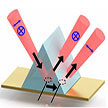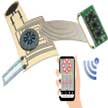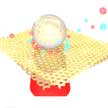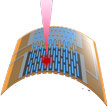Showing Spotlights 49 - 56 of 240 in category All (newest first):
 Photodetectors with blackbody response show significant applications in remote sensing and infrared imaging. However, up to now, few works have demonstrated excellent response to blackbody radiation (weak irregular radiation from a real object), which is essential to reliably evaluate their potential in practical detections. Researchers now have demonstrated van der Waals unipolar barrier photodetectors with nBn and pBp heterostructures. Designing unipolar barriers with conventional materials is challenging due to the strict requirements of lattice and band matching.
Photodetectors with blackbody response show significant applications in remote sensing and infrared imaging. However, up to now, few works have demonstrated excellent response to blackbody radiation (weak irregular radiation from a real object), which is essential to reliably evaluate their potential in practical detections. Researchers now have demonstrated van der Waals unipolar barrier photodetectors with nBn and pBp heterostructures. Designing unipolar barriers with conventional materials is challenging due to the strict requirements of lattice and band matching.
Jun 24th, 2021
 Researchers have significantly enhanced the performance of a surface plasmon resonance (SPR) biosensing platform by adding an atomically thin phase change material to the sensor. This plasmonic sensing device exhibits a detection limit of 1 femtomol for tumor necrosis factor (TNF alpha) biomarkers , which is more than three orders of magnitude compared to current state-of-art nanomaterial-enhanced plasmonic sensors. It also detects small biotin molecules with a sensitivity of 10 femtomols. This sub-attomole detection level is a significant improvement compared to other SPR designs.
Researchers have significantly enhanced the performance of a surface plasmon resonance (SPR) biosensing platform by adding an atomically thin phase change material to the sensor. This plasmonic sensing device exhibits a detection limit of 1 femtomol for tumor necrosis factor (TNF alpha) biomarkers , which is more than three orders of magnitude compared to current state-of-art nanomaterial-enhanced plasmonic sensors. It also detects small biotin molecules with a sensitivity of 10 femtomols. This sub-attomole detection level is a significant improvement compared to other SPR designs.
Apr 19th, 2021
 Wearable flexible sensors have recently emerged as promising alternatives for human healthcare monitoring due to their lightweight and thin-film-based nature. However, few of these flexible sensor systems are applicable to neonatal monitoring, especially sleeping posture detection. Researchers now report a versatile laser-induced-graphene-based integrated sensor system, which can wirelessly monitor sleeping postures, respiration rate, and diaper wetness with feedback alarm functions.
Wearable flexible sensors have recently emerged as promising alternatives for human healthcare monitoring due to their lightweight and thin-film-based nature. However, few of these flexible sensor systems are applicable to neonatal monitoring, especially sleeping posture detection. Researchers now report a versatile laser-induced-graphene-based integrated sensor system, which can wirelessly monitor sleeping postures, respiration rate, and diaper wetness with feedback alarm functions.
Mar 31st, 2021
 Researchers demonstrate label-free chiral detection of metabolic molecules at picomolar level through microbubble-induced rapid accumulation of biomolecules on plasmonic chiral sensors, which shows a 10-million times enhancement in sensitivity comparing to state-of-the-art plasmonic chiral sensors. The researchers achieved their ultrahigh sensitivity in chiral sensing of biomolecules by utilizing two enhancement mechanisms: the microbubble-induced accumulation of biomolecules onto the chiral plasmonic substrates; and the subsequent plasmon-enhanced chiral sensing.
Researchers demonstrate label-free chiral detection of metabolic molecules at picomolar level through microbubble-induced rapid accumulation of biomolecules on plasmonic chiral sensors, which shows a 10-million times enhancement in sensitivity comparing to state-of-the-art plasmonic chiral sensors. The researchers achieved their ultrahigh sensitivity in chiral sensing of biomolecules by utilizing two enhancement mechanisms: the microbubble-induced accumulation of biomolecules onto the chiral plasmonic substrates; and the subsequent plasmon-enhanced chiral sensing.
Mar 30th, 2021
 Researchers have demonstrated the large-scale fabrication of skin-interfaced printed microfluidic patches, capable of multiplexed electrochemical detection of biomarkers from human sweat. This sensor continuously and simultaneously measures the level of biomarkers such as lactate, Na+, K+, and pH during sweating. The skin-worn sensor can selectively measure analytes even in the presence of other interfering species present in sweat. The patch is integrated with a custom-made miniature printed circuit board that enables multiplexed decoding of sweat and wireless signal transduction to the host devices and is completely free from any sensor-to-sensor transfer of signals.
Researchers have demonstrated the large-scale fabrication of skin-interfaced printed microfluidic patches, capable of multiplexed electrochemical detection of biomarkers from human sweat. This sensor continuously and simultaneously measures the level of biomarkers such as lactate, Na+, K+, and pH during sweating. The skin-worn sensor can selectively measure analytes even in the presence of other interfering species present in sweat. The patch is integrated with a custom-made miniature printed circuit board that enables multiplexed decoding of sweat and wireless signal transduction to the host devices and is completely free from any sensor-to-sensor transfer of signals.
Mar 29th, 2021
 In order to realize practical device applications of stretchable strain sensors, stability without sacrificing sensitivity, stretchability, and scalability is crucial. To that end, researchers report a kirigami-structured graphene-polymer hybrid nanocomposite for strain sensors by a laser direct writing technique on a polyimide sheet. The approach of laser direct writing not only contributes to the conversion of polyimide material into conductively porous carbonized film, but also gives rise to the formation of kirigami-shaped structures with highly stretchable capability in a fast and efficient manner.
In order to realize practical device applications of stretchable strain sensors, stability without sacrificing sensitivity, stretchability, and scalability is crucial. To that end, researchers report a kirigami-structured graphene-polymer hybrid nanocomposite for strain sensors by a laser direct writing technique on a polyimide sheet. The approach of laser direct writing not only contributes to the conversion of polyimide material into conductively porous carbonized film, but also gives rise to the formation of kirigami-shaped structures with highly stretchable capability in a fast and efficient manner.
Mar 23rd, 2021
 An overview of feedback-driven, skin-like multifunctional sensor systems, from the basic material/structural design to applications. Emerging functional nanomaterials and innovative structures for constructing flexible sensors are highlighted, followed by an introduction of various integrated flexible sensor systems. Several categories of feedback sensor systems are described in terms of prosthesis- and AR/VR-based human-machine interfaces, smartphone-based approaches for point-of-care detection, and smart wearable displays for direct signal visualization. The profound significance of these innovations is also highlighted.
An overview of feedback-driven, skin-like multifunctional sensor systems, from the basic material/structural design to applications. Emerging functional nanomaterials and innovative structures for constructing flexible sensors are highlighted, followed by an introduction of various integrated flexible sensor systems. Several categories of feedback sensor systems are described in terms of prosthesis- and AR/VR-based human-machine interfaces, smartphone-based approaches for point-of-care detection, and smart wearable displays for direct signal visualization. The profound significance of these innovations is also highlighted.
Dec 28th, 2020
 Explosive trace detection (ETD) is a challenging task. Various factors, such as wide variety of compounds that can be used as explosives, the vast number of deployment means, and the lack of inexpensive sensors providing both high sensitivity and selectivity, have made trace detection a complex and costly task. Whereas animals still remain a benchmark for emerging technologies with key attributes being high selectivity, sensitivity, concurrent detection of multiple analytes, and fast screening times, it is likely that nanomaterials will play an important role in the development of much improved future ETD technologies.
Explosive trace detection (ETD) is a challenging task. Various factors, such as wide variety of compounds that can be used as explosives, the vast number of deployment means, and the lack of inexpensive sensors providing both high sensitivity and selectivity, have made trace detection a complex and costly task. Whereas animals still remain a benchmark for emerging technologies with key attributes being high selectivity, sensitivity, concurrent detection of multiple analytes, and fast screening times, it is likely that nanomaterials will play an important role in the development of much improved future ETD technologies.
Aug 26th, 2020
 Photodetectors with blackbody response show significant applications in remote sensing and infrared imaging. However, up to now, few works have demonstrated excellent response to blackbody radiation (weak irregular radiation from a real object), which is essential to reliably evaluate their potential in practical detections. Researchers now have demonstrated van der Waals unipolar barrier photodetectors with nBn and pBp heterostructures. Designing unipolar barriers with conventional materials is challenging due to the strict requirements of lattice and band matching.
Photodetectors with blackbody response show significant applications in remote sensing and infrared imaging. However, up to now, few works have demonstrated excellent response to blackbody radiation (weak irregular radiation from a real object), which is essential to reliably evaluate their potential in practical detections. Researchers now have demonstrated van der Waals unipolar barrier photodetectors with nBn and pBp heterostructures. Designing unipolar barriers with conventional materials is challenging due to the strict requirements of lattice and band matching. 
 Subscribe to our Nanotechnology Spotlight feed
Subscribe to our Nanotechnology Spotlight feed





